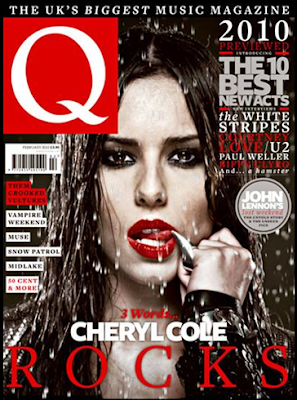 NME is a music magazine aimed at 15-24 year olds, particulary young males who enjoy seeing their favourite bands at various venues and festivals. The magazine consists of montages of pictures rather than in-depth articles due to their readership. It sees its self as more as a newspaper than a magazine, as the title suggests, and reports on the latest gossip in the music world.
NME is a music magazine aimed at 15-24 year olds, particulary young males who enjoy seeing their favourite bands at various venues and festivals. The magazine consists of montages of pictures rather than in-depth articles due to their readership. It sees its self as more as a newspaper than a magazine, as the title suggests, and reports on the latest gossip in the music world.The title block tells us that the magazine is attempting to attract the youth with its bold lettering, the pointed 'M' also suggests that the magazine is 'cutting edge' and can offer new music to its young readers. The colours are also very bold which is something that the readership seeks as they search for who they really are. The title is also pronounced 'Enemy' which connotes the readership attempting to 'stick it to the man', it also suggests that the magazines enemy is popular culture, with this being the same enemy as the readership.
From the front cover, the magazine covers the latest news in music, there are puffs that read "Jay Reatard RIP" and "Courtney and Keef, Worst Duet Ever?", this tells the readership and potential readers that the magazine will cover the general news of the music world, particulary the indie genre. The puffs also suggest that the readership will know about indie music and non-mainstream music, you wouldn't expect a fan of The Saturdays to read this magazine.
They also use the buzz word 'Plus' to give the readership the sense that they are getting more content for their money.
The central image is of Gerrard Way from My Chemical Romance, NME wants us to feel like we have a relationship with him due having a direct mode of address. However, his body is twisted away from the camera and only half of his face is on view, this suggests that NME wants to create an element of mystery around Gerrard Way, they want us to know him but not the whole of him.
Gerrard is on the front cover due to the upcoming release of My Chemical Romance's new album. NME can take advantage of the huge fanbase of the band who will buy this new issue simply because Gerrard Way is on the cover. NME can also draw in a bigger readership as Gerrard is talking about their new album; My Chemical Romance have'nt released an album since 'The Black Parade' went platinum in 2006.
The anchorage text attached to the image suggests to the reader that My Chemical Romance have rebranded themselves. The text reads "My Chemical Romance, On Their Punk Comeback Album", this tells the reader that the band has developed since their last album. Also by having the quote from Gerrard Way attached the readership will feel like Gerrard Way is telling them directly about the bands new image and sound.
The overall image being portrayed by the artist is an uncaring one, it seems that the artist doesn't care whether we like him or not. Also there is an element of mystery surrounding Gerrard Way as his mode of address makes the audience feel as if he is hiding something.
The magazine follows a red, white and black colour theme with the title block following suit. This gives the reader the idea of mystery and danger, something that Gerrard Way also wants to demonstrate. Also if they used more than three colours the magazine could look trashy, this is something that NME wants to avoid as it would be off putting to its readership.
NME attempts to attract readers by mentioning numerous bands and artists on the front cover, the audience gets the sense that they will be getting more for their money. They also feature less known artists that dont really get coverage in other music magazines, so they appeal to a niche market. This issue also has new Gorillaz art and interview with them being a very popular band.




